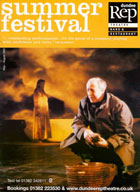Dundee Repertory Theatre
This collection includes drawings and plans, photographs, programmes, leaflets and presscuttings, minutes of meetings and correspondence.
Robert Thornely, manager of the last touring company to perform in Dundee was determined to find a home in the city for his professional theatre company. He approached the Dundee Dramatic Society, an amateur company, who had recently purchased their own premises in the form of a disused jute mill. In May 1939 Dundee Repertory Theatre was founded as a collaboration between professionals with amateur support. The company faced disaster in June 1963 when a fire completely destroyed the Rep’s home at the Foresters’ Hall building and was forced to live a nomadic existence for a short period. Eventually a temporary refuge was found in a converted church on the Lochee Road of Dundee although the company remained at the venue for a further 18 years.
After negotiation with the District Council and the Scottish Arts Council it was agreed that the company would have its own purpose built premises on land donated by University of Dundee. Work began in January 1979 under the leadership of Robert Robertson who had been Artistic Director for a number of years. However, the building work looked like being stopped in its tracks due to rising prices and inflation. A public appeal was launched which raised a massive £60,000 in under six weeks, reaching an eventual total of £200,000. The new theatre opened on April 8, 1982, designed by Dundee based architects Nicoll Russell studios .
In April 1992 Hamish Glen was appointed Artistic Director, the same year saw the building extended and undertook a major refurbishment to facilitate a growing community and education department and to include a dance studio as well as extending its existing workshop, wardrobe and rehearsal capacity.
How to find material relating to Dundee Repertory Theatre
- Browse through a list of documents or events associated with Dundee Repertory Theatre or use the Name Search option on the Scottish Theatre Archive Search
See also
- Dundee Repertory Theatre: details of latest and future productions, plus latest news, information and photographs outlining the history of the theatre
